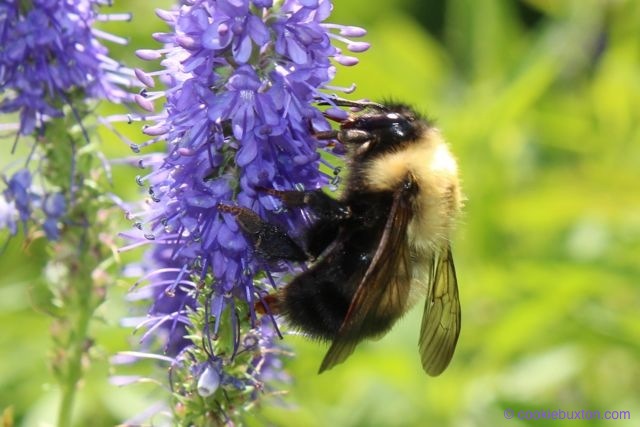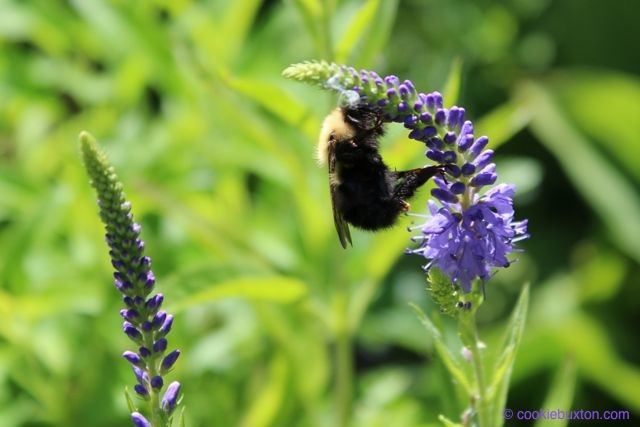Gentle garden bumblebees
The most wonderful sound in the garden is made by the best of all garden visitors – the “humble” garden bumblebee.
Big round bumblebees were a common sight in my youth, and I am grateful to say that along our little stretch of properties in my urban zone three neighbourhood, the garden bumblebee is here in abundance. I have this year seen several of the very large bees, perhaps they are queens, about an inch long, enjoying the nectar from the spikes of veronica in my garden, and I see literally hundreds of smaller worker and drone bees moving through the garden every day.
Bumblebees differ from honeybees in many ways. According to Bug Guide, there are about 50 native species of garden bumblebees out of roughly 4,000 native bee species (including honey bees, and all other types) in North America.
Bumblebee Profile by Pollination Canada notes that 24, or roughly 10%, of the overall 250 species that are classified as bumblebees worldwide are present in Canada.
Bumblebees are noticeably furry, whereas the honeybees are smooth, and are memorable for their yellow, black, orange and white stripes, arranged according to the species’ distinctive markings. Bumblebees are classified into families of similar characteristics; they are social creatures, living in small colonies, and they generally build their nests in or near the ground.
Today, as almost everyone is hopefully aware, our bees are in serious trouble. There have been issues of honeybee colonies dying recorded from time to time over the centuries, but the present issue is astonishingly drastic. Honeybees, particularly, have been very seriously affected by the widespread commercial use of pesticides and insecticides. If you have not already read about CCD – the term Colony Collapse Disorder was coined in 2006 – affecting North American honeybee colonies, please inform yourself and take whatever action you are able to do on a personal level to help restore proper health to these important members of the insect kingdom.
In my city, our government had for years been using malathion spraying programs as one of its strategies to control urban mosquito populations. Malathion is toxic to bees. I was thrilled when they moved to a policy of introducing dragonflies as an alternative strategy for lowering mosquito counts.
While toxicity to wild garden bees from the use of chemicals can be managed – utilizing nighttime spraying, for example, which provides time for the toxicity to reduce while the garden bumblebees are hopefully resting in their nests – I can nonetheless recall many a morning after a spraying when the garden was “deathly quiet.” Many of my bees do sleep in the open, on the undersides of leaves. There was often no humming, no buzzing, no sweet sounds of nectar and pollen collection in the days and weeks following a spraying.
In addition to the community insect control program, for a year or two we contracted for commercial lawn care services to fertilize the grass and control the weeds on our lawn. We have stopped this practice, and now manage weeds by hand digging, while leaving some growing for the insects. The queen bumblebee, in fact, relies on a few dandelions and other early flowers in the spring as nectar sources when coming out of winter hibernation.
It has been many years now that our garden has been almost completely clear of chemicals. Over this period, I have become much better informed around the issues. I did resort to spraying about four years ago to control a two-year invasion of white flies that was creating tremendous stress on my Virginia creeper, and I felt this was needed to get the insect population under control. In other respects, however, the garden is clean and pesticide-free. My neighbour also manages her garden in a similar manner.
In addition to having a pesticide-free yard, I have plantings that the bumblebees seem to love. The bumblebees in my garden are drawn to the blue and violet and purple garden flowers that are plentiful here. I have at least ten separate plantings of Veronica “Sunny Border Blue” scattered throughout my yard, and I can usually spot about a dozen bees when I am passing by these plantings.
One of the things I know about my garden bees, apart from how amazingly important they are, is that they are not aggressive. I put my face down in the plants while digging out weeds, and they buzz around me without stinging me. The bees let me lean in close for photographs, and go about their business without attacking me. I realize that some people suffer severe and life-threatening allergies to insect stings. They need to be extremely cautious. In general, however, bees are intent on their tasks and not paying much attention to what you or I do around them.
They are wonderful partners in the garden.
The male bumblebee drones that you encounter in the summer are tasked with collecting food, and they are not equipped to sting. The female worker bees that are active in the spring and early summer building and feeding the small garden colony do have stingers, and unlike wasps, do not die after stinging you. They are capable of stinging repeatedly. You want to avoid violating the bees’ sense of territory. Be careful not to stumble onto their nests along the edges of sheds, under rocks, and in holes in the earth. Leave them in peace, and they in turn will carry out their role of pollinating the plants that rely on them for their very existence.
And if you see a queen bee flying through your garden in spring, when she is nourishing herself and collecting food and selecting her new nest location, or in late summer or fall, when she is intent on mating, leave her in peace. Keep your plants clean and free of chemicals so that she is not poisoned. She is the only member of the garden bumblebee colony that survives to start a new colony of garden bees the following year. All of the bees, the original queen bee, the 50-to-150 females and males that she produces, live purposefully for one short season and die before winter. Only the queen bees born in late summer, newly mated, survive to carry on the species.
The gentle northern garden bumblebees, and all of us, depend upon the ability of the young queens to make it through the long winter, when they will start their new colonies and begin the pollination process anew in spring.
For information on native bumblebees in North America, these sites may interest you:
Bug Guide
Bumblebee.org
Seeds.ca
Photos & Text: NK
Photo ID: 1308_35; 1308_36
Location: Home garden
Copyright: cookiebuxton.com

